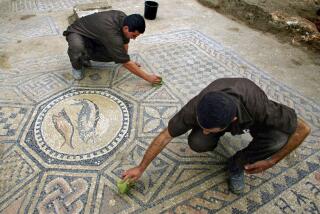Legend and Myth Embellish Story of Site Revered by Three Religions
- Share via
“Stories about Jerusalem should not be dismissed because they are ‘only’ myths,” historian Karen Armstrong once observed. “They are important precisely because they are myths.”
The same powerful insight suffuses “The Rock,” a work of fiction that dares to imagine exactly when, why and how the outcrop of stone that was believed to be the site of the ancient temple of Solomon in Jerusalem--already sacred to both Judaism and Christianity--was first claimed as a holy place by Islam in the 7th century, thus establishing Jerusalem as ground zero in the bloody and enduring conflict among the three great monotheistic faiths.
Born in Baghdad, trained as an architect and famous for his leadership of the Iraqi human rights movement, Kanan Makiya is the author of several courageous books and documentaries about the regime of Saddam Hussein, including “Republic of Fear.” Scholarship, he asserts in “The Rock,” cannot fully illuminate the circumstances under which the Arab conquerors of Jerusalem were inspired to build the Dome of the Rock, the shrine that still stands atop the Temple Mount.
“We know too little,” Makiya explains in an illuminating appendix. “So much has been irretrievably lost.” But he found his way to a wealth of legend and lore, mostly drawn from Islamic sources, and he makes good use of myth to fill in the blank spaces of history. “Fiction,” he says, “has stepped into the breach.”
The crucial figure who inspired Makiya to write “The Rock” is Ka’b al-Ahbar, a Jewish convert to Islam (and, possibly, an ex-rabbi) who marched into Jerusalem with its conqueror, the Muslim caliph Umar ibn al-Khattab. An authority on Jewish scripture and a gifted teller of tales, Ka’b transmitted to Islam some of Judaism’s oldest beliefs about the sanctity of Mount Moriah, the traditional site of Solomon’s temple. “The Rock” is narrated by a character named Ishaq, the son of the historical Ka’b. As conjured up by the author, Ishaq is the architect of the Dome of the Rock and, not incidentally, the chronicler of his father’s life and collector of the tales he once told. Through Ishaq’s eyes, we see how three religions rooted themselves in the rocky soil of Jerusalem and we also see the audacious structures that human beings were inspired to build there.
“The Rock will always be itself, a plain and humble piece of limestone no different from the other stones upon which this Holy City is built, but in what way does it partake in the nature and mystery of God?” muses Ishaq. “Justifications of conquests, apologias of defeat, tales of victory and of woe, rituals of worship, all mixtures of lies and truths have become wondrous stories accumulating around Moriah’s weather-beaten face ever since men first fixed their eyes upon it.”
“The Rock” is full of wonders. Ka’b is present at the Prophet’s last sermon in Medina: “Muhammad was too weak to climb the pulpit or even stand upright,” recalls Ishaq. “Yet even in sickness . . . his white face radiated sweetness and was as luminous as the moon.” Father and son are eyewitnesses to the conquest of Jerusalem by the caliph Umar: “Like King David and Nebuchadnezzar before him, the caliph took his first view of the Holy City from the Mount of Olives.”
Ishaq is recruited to design the Dome of the Rock, and he allows us to see that realpolitik as well as architectural genius and true belief figured in the enterprise--its builders sought to trump the claims of Judaism and Christianity to the city that was now ruled by Islam.
“Only Jerusalem,” reasoned the caliph who commissioned the building of the shrine, “could put Muhammad’s people at the center of things, where they belonged.” And, as if to tweak the sensibilities of more pious readers, Ishaq offers a detailed description of how the remnants of the prior owners and users of the Rock--”Roman, Jewish, Christian or pagan”--were carefully concealed behind the retaining walls on which the shrine itself was to be built.
“The greater the amount of rubble at our disposal--the greater, in other words, had been Roman and Christian desecration of the site of Solomon’s temple--the higher would our platform rise, and the more triumphantly would Abd al-Malik’s dome tower above the city skyline,” reports Ishaq. “Was this God’s way of punishing those who had so abused his Rock? Thus did I wonder at destiny’s design while watching the Rock I had known as a young boy get buried until only its tip was left exposed.”
The same passion for human dignity and human diversity that Makiya brings to his work in politics shines through in his storytelling. Above all, in “The Rock” he describes Islam to the rest of the world in words and images that both explain and transcend the headlines. Clearly, though he has aspired to write a book for the ages, “The Rock” could not be more timely.
Jonathan Kirsch, a contributing writer to the Book Review, is the author, most recently, of “The Woman Who Laughed at God: The Untold History of the Jewish People” (Viking).
More to Read
Sign up for our Book Club newsletter
Get the latest news, events and more from the Los Angeles Times Book Club, and help us get L.A. reading and talking.
You may occasionally receive promotional content from the Los Angeles Times.










